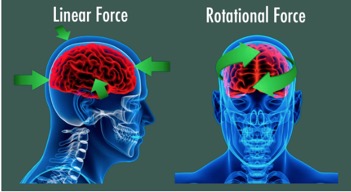What is a concussion?
A concussion is a traumatic brain injury defined as a complex process affecting the brain caused by external mechanical forces. A concussion is caused by force transmitted to the head or body, which causes movement of brain tissue within the skull. The high-speed movement of the brain tissue inside and against the skull causes concussion and is not always caused by a direct impact to the head.
Causes of a concussion:
- Linear acceleration caused by: whiplash and direct impact front on, such as a head clash,
- Vertical acceleration caused by compression: from a direct blow to the top of the head or from landing from a significant fall/jump,
- Angular acceleration caused by head/neck rotation: a large tackle where your trunk is twisted one way and your head/neck in the opposite direction or a direct impact to the side of the head or body.
Common signs and symptoms of a concussion
- Loss of consciousness
- Dizziness
- Headache
- Confusion
- Irritability
- Neck pain
- Blurred vision
- Drowsiness
- Nausea or vomiting
- Balance problems
- Seizures and or convulsions
- Fatigue /low energy
- Nervous /anxious
- Feeling slowed down
- Difficulty remembering
- Feeling foggy
- Sensitive to light or noise
- Difficulty concentrating
Related injuries
- Neck and spinal cord injuries,
- Facial and skull fractures,
- Tooth loss and dental fractures,
- Lacerations,
- Upper back and abdominal trauma,
- Ear impairment,
- Musculoskeletal injuries.
The 5 R's of concussion management
- Recognise the injury
- Remove from play (when safe, following DRABCD)
- Refer to a Doctor
- Rest
- Return to Play only when cleared by Doctor. A person with a SUSPECTED concussion must be removed from play immediately. A health professional should assess the player BEFORE returning to play.

Concussion recognition tools
Recognition tools should be used to assess a person with a suspected concussion. There are two recognition tools that can be used which include:- Concussion recognition tool 5 (for use by anyone) can be found online through the British Journal of Sports Medicine for free download and use.
- SCAT 5 is used by licensed health professionals only.
Physiotherapy treatment for a concussion
A physiotherapist can differentiate the various causes of symptoms after a thorough concussion assessment that includes several concussion tests. Implementing your concussion management treatment plan would then focus on different symptom areas.Effects of a concussion on the cervical spine
If a concussion injury has affected the neck or spine, a physiotherapist can assist with:- Neck muscle strengthening.
- Manual therapy is used to ensure that the joints are moving freely.
- Myofascial release techniques are used to ensure that the surrounding soft tissue is mobile.
Vestibular problems following a concussion
Balance training can help with vestibular problems such as dizziness or imbalance. Repositioning of the canalith, a head manoeuvre to move the ear crystals to an area of your inner ear that eases dizziness.Visual disturbances following a concussion
If a concussion affects vision, ocular reflex training can be prescribed to improve visual motor control and reduce visual disturbances.Exertion problems following a concussion
As part of a concussion management plan, exercise prescriptions should include incremental progressions of individually tailored exercises if exertion is a problem.Post-concussion complications
- Impaired performance.
- Increased risk of injury on return to play.
- 5-10% suffer prolonged symptoms (post-concussion syndrome).
What is post-concussion syndrome?
Post-concussion syndrome is defined as the "arbitrary persistence of symptoms beyond normal" following a concussion, whereas a concussion usually results in a spontaneous resolution of symptoms. It appears to be more likely if the initial concussion is severe or poorly managed. Post-concussion syndrome can include persistent headaches or fatigue, dizziness, and mood or sleep disturbance.

